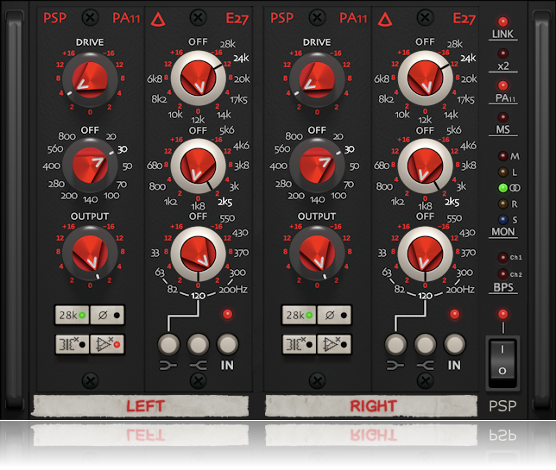Avedis® PSP E27
Features
- Software plug-in modeled after the Avedis® E27
- Oversampled for smoother analog type high frequencies
- 3-bands with 9 frequencies per band with x2 for additional bands
- ±16 dB of boost and cut
- Shelving option for low and high frequencies
- PA11 pre-amp stage for global output level control
- Selectable high-pass filter
- DRIVE feature increases input while simultaneously decreases output
- Suitable for tracking, mixing, and mastering
- Mac OSX – AudioUnit, VST3, VST, AAX and RTAS
- Windows – VST3, VST, AAX and RTAS
Avedis® PSP E27 Multistage Equalizer Plug-in
The PSP E27 is a multistage equalizer plug-in (VST3, VST, AAX and RTAS for Windows; AudioUnit, VST3, VST, AAX and RTAS for Mac OSX) modeled after our analog equalizer E27. The PSP E27 offers three-band equalization with nine selectable frequencies in a standard 500x package. The PSP E27 equalizer offers +/-16dB of boost/cut at musicially selected frequency ranges, and offers gentle saturation. Low and high filters can work in bell or shelf mode with a single click. The PSP E27 is suitable for both mixing and mastering and it offers an additional preamp stage for global level control. The PSP E27 EQ plug-in also catches nonlinear behavior of analog devices.
PSP is the sole developer and manufacturer of the PSP E27. Functionality and sound of the PSP e27 have been approved by Avedis Audio Electronics. PSP is responsible for all customer support.
FAQ
Why frequencies up to 28kHz?
When you boost or cut a chosen frequency, it is shaped like a bell unless you push in the shelving button – then it’s half a bell where the top of it extends beyond the selected frequency. The top of the bell would be 28kHz, for example, but the curve leading up to the top starts at frequencies within the fundamentals, or within 20khz. So you will easily hear the effect at the very tail end of the audible spectrum without accentuating siblance or already aggressive high frequency in the source. PSP worked hard to have higher frequencies sound smooth and retain much of the harmonics found in the E27 hardware. After you hear it, it will be part of your eq vocabulary.
How does it compare to the hardware E27?
It was not an easy task for PSP Audioware to make the E27 plug-in. There was a lot of data which needed to be studied which included studying the original hardware schematics, performance graphs and audio analysis, and lots of listening tests from people who’s ears we trust.
Is there a characteristic sound to the hardware EQ?
Yes. One way to tell is to have some music playing on your favorite monitors, and suddenly patch the eq in the chain, but without any boost or cut and even with the IN button not engaged. Listen carefully and what you will hear is the characteristic sound. Though the frequency response is flat when no eq is used, an increase in depth is often noticed with this simple test.
Nothing is transparent; everything has a sound.
How narrow is the bandwidth?
The bandwidth (also called Q) varies depending on how much boost or cut there is. The more you boost, the narrower the Q, going from a fairly a broad bandwidth to medium.
Here is a graph of this Relative Q feature.
Bell vs Shelf using the two push-buttons at the bottom... Explain.
The Low and High frequencies have a Shelf option which can be used to affect the band before the chosen frequency when using the Low band making it a great adjustable High-Pass Filter, or it could affect the band after the chosen frequency in the High band for larger scale tone shaping. See Graphs.
On the Low band, why does the Shelf start at 63Hz and not at 33Hz?
If you are at 33Hz, the -3db point with the bell is near 15Hz so it’s not really practical to have shelving at 33Hz with this eq. As the graph can also show, having a Shelf at 33Hz would not do any good.

